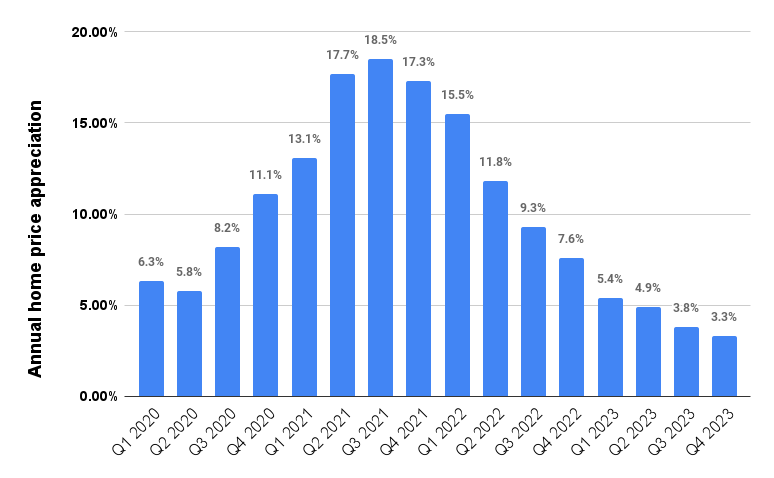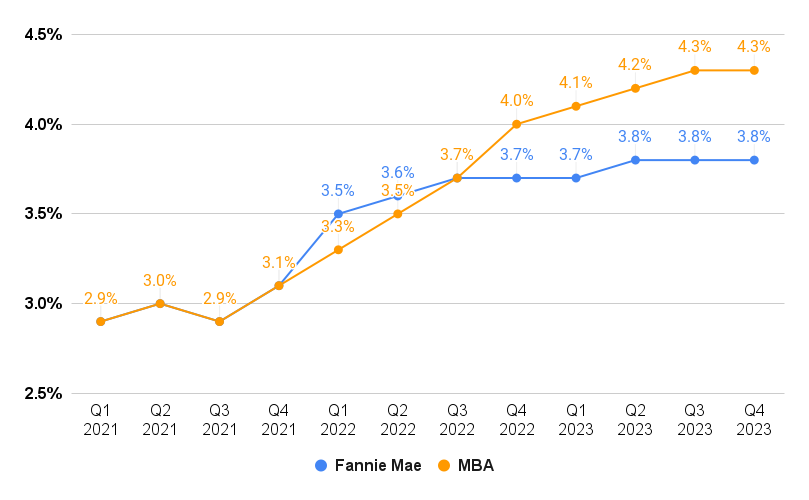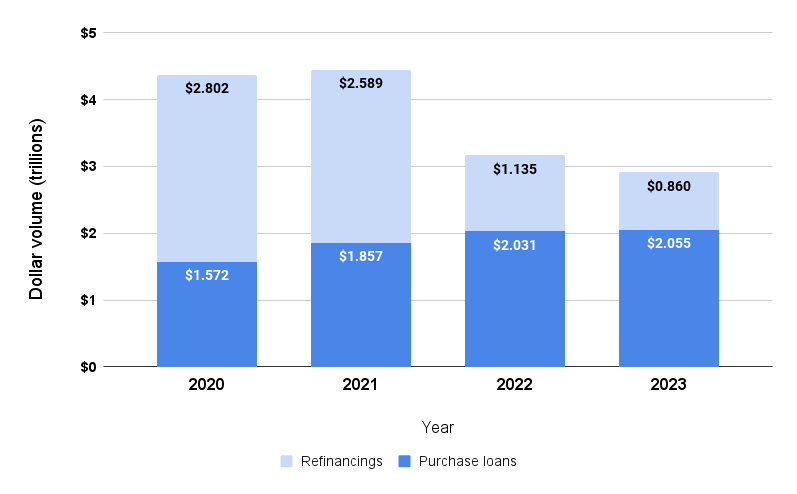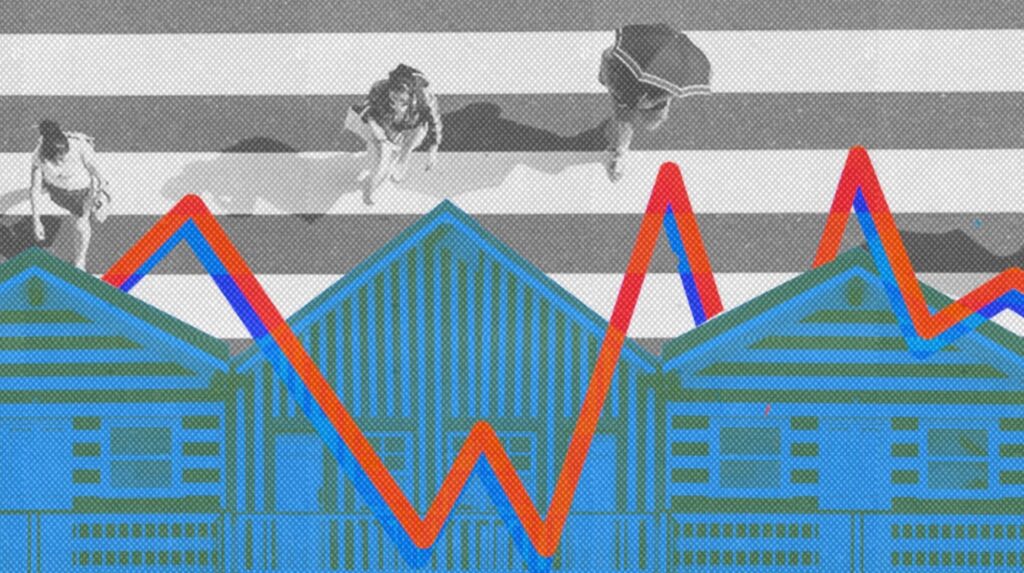Rising mortgage rates and home prices should translate into fewer bidding wars in the months ahead, but there’s still plenty of pent-up homebuyer demand to prop up home sales this year.
That’s according to the latest forecast from economists at Fannie Mae, who do expect a “significant” quarter-over-quarter decline in home sales following an end-of-year surge that appears to have been at least partially driven by homebuyers rushing to lock in low rates.
While Fannie Mae forecasters expect that the Federal Reserve will raise short-term rates by a full percentage point over the next several months, they see mortgage rates stabilizing later this summer as the Fed pauses in July to assess the effects of tightening.
If that happens, the recent runup in mortgage rates and home prices could help cool home price appreciation — without putting a major dent in home sales this year.
Projected home sales
Projected 2022 and 2023 sales of new and existing homes. Source: Fannie Mae Economic & Strategic Research Group.
While Fannie Mae economists expect sales of existing homes will fall by 4.6 percent this year, to 5.84 million, that’s a far cry from the 9 percent drop seen the last time mortgage rates rose by a full percentage point. And the expected 15 percent growth in new home sales, to 879,000, would mean sales of new and existing homes would slip by only 2.4 percent this year, to 6.72 million.
With homes still in short supply, many would-be homebuyers lost out in bidding wars but may still be in the market for a home.
“We therefore see growing affordability challenges not hindering sales as greatly in the near term as they otherwise would have,” Fannie Mae economists said. “The effect of buyers being priced out should mean fewer bidding wars and slower house price appreciation, but not a lack of transactions.”
If mortgage rates and home prices keep going up, that could spell trouble in the longer term, however, with sales of new and existing homes expected to decline by another 3.4 percent in 2023.
“The percent of median household income required to pay the mortgage on a median-priced home using current mortgage rates has now eclipsed the last cycle’s high reached in late 2018 and is near levels comparable to the early 2000s prior to the bubble years,” Fannie Mae forecasters said. “In our view, this isn’t an immediate cause for concern, but we believe home purchase demand is likely to soften going forward as mortgage payments no longer look affordable relative to the historical range. Increasingly, more potential buyers are likely to be priced out.”
Projected home price appreciation

Projected 2022 and 2023 annual home price appreciation, by quarter. Source: Fannie Mae Economic & Strategic Research Group.
The good news is that Fannie Mae economists see home price appreciation decelerating considerably, to 7.6 percent by the end of this year, down from 17.3 percent in the final three months of 2021.
New single-family home construction should help offset some of the impact of continuing shortages of existing homes, and help affordability.
“The limiting factor for new home sales is a matter of how quickly builders can overcome materials shortages, supply chain bottle necks, and labor scarcity, in order to work through their production backlog,” Fannie Mae forecasters said.
Projected mortgage rates

Projected 2022 and 2023 mortgage rates. Source: Fannie Mae Economic & Strategic Research Group, Mortgage Bankers Association.
Fannie Mae forecasters expect mortgage rates to stabilize at 3.7 percent in the second half of 2022, as the Fed takes stock of short-term interest rate hikes that are seen as inevitable this spring. Although a daily index of rate lock data compiled by Optimal Blue shows mortgage rates have already breached 4 percent for many borrowers, Fannie Mae’s forecasts track a weekly survey by Freddie Mac.
“Inflation continues to accelerate, hitting a new forty-year high in January. As a result, the Federal Reserve looks poised to begin a more aggressive tightening policy than previously anticipated,” Fannie Mae forecasters said. “We now expect a 50-basis point hike to occur in March, the beginning of a multi-year tightening period through 2023.”
Regardless of whether the Fed’s initial March rate hike is 25 or 50 basis points, Fannie Mae economists expect a full 100 basis points of cumulative increases in the federal funds rate by the end of July.
“Where we currently differ in our view from futures markets, however, is that after the initial rate hikes, we are forecasting a pause from July until the end of the year as the Fed assesses the effects of both the rate changes to date as well as the consequences of beginning to let its balance sheet run off,” Fannie Mae forecasters said.
The Fed’s $120 billion in monthly purchases of government debt and mortgage-backed securities during the pandemic helped bring interest rates to historic lows, but also swelled the Fed’s balance sheet to nearly $9 trillion.
Now that the Fed has wound down those purchases, some policymakers are eager to start shrinking the Fed’s balance sheet — which could also put upward pressure on interest rates.
Since Fed policymakers “have less experience with this policy tool relative to fed funds rate increases,” there’s “a heightened level of uncertainty around the actual effects of the balance sheet runoff,” Fannie Mae economists said of their expectations that the Fed will pause its interest rate hikes in July.
Unknowns that could impact that pace of rate hikes include political tensions in Ukraine, and unforeseen COVID-related disruptions to consumer behavior and the labor market, Fannie Mae forecasters said.

Doug Duncan | Photo credit: Fannie Mae
“Headline inflation will likely decline from year-ago levels as price pressures ease, but upward price pressures are not expected to be as fleeting as initially thought — and it’s likely that the period of time required for inflation to be reversed has been extended significantly,” said Fannie Mae Chief Economist Doug Duncan, in a statement. “Compared to a few months ago, financial markets now expect a substantially more aggressive monetary posture from the nation’s central bank, which is likely to result in heightened volatility as the Fed retains the optionality necessary to engineer a non-inflationary soft landing.”
Projected mortgage originations

Projected 2022 and 2023 mortgage originations. Source: Fannie Mae Economic & Strategic Research Group.
While Fannie Mae economists see home sales dipping slightly this year, home price increases mean that purchase mortgage originations will grow by about 9 percent, to $2.03 trillion.
Refinancings are expected to drop 56 percent, however, to $1.13 trillion, as fewer homeowners are able to beat their existing rate.
Get Inman’s Extra Credit Newsletter delivered right to your inbox. A weekly roundup of all the biggest news in the world of mortgages and closings delivered every Wednesday. Click here to subscribe.



 Are You Interested in West Eleventh Residences Miami?
Are You Interested in West Eleventh Residences Miami? Are You Interested in ONE Park Tower by Turnberry?
Are You Interested in ONE Park Tower by Turnberry? Are You Interested in Diesel Wynwood Condominium?
Are You Interested in Diesel Wynwood Condominium? Are You Interested in Five Park Miami Beach?
Are You Interested in Five Park Miami Beach? Are You Interested in Cipriani Residences Miami?
Are You Interested in Cipriani Residences Miami? Are You Interested in Bentley Residences Miami?
Are You Interested in Bentley Residences Miami? Are You Interested in Baccarat Residences Brickell?
Are You Interested in Baccarat Residences Brickell? Are You Interested in Aria Reserve Miami?
Are You Interested in Aria Reserve Miami? Are You Interested in 888 Brickell Dolce & Gabbana | Miami?
Are You Interested in 888 Brickell Dolce & Gabbana | Miami? Are You Interested in 600 Miami WorldCenter?
Are You Interested in 600 Miami WorldCenter? Are You Interested in HUB MIAMI RESIDENCES?
Are You Interested in HUB MIAMI RESIDENCES? Are You Interested in WALDORF ASTORIA RESIDENCES?
Are You Interested in WALDORF ASTORIA RESIDENCES?